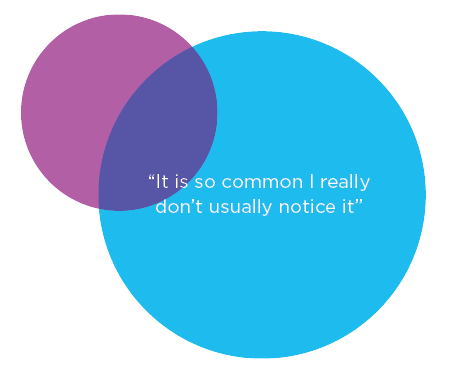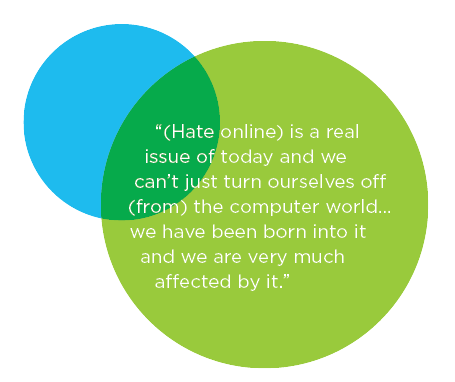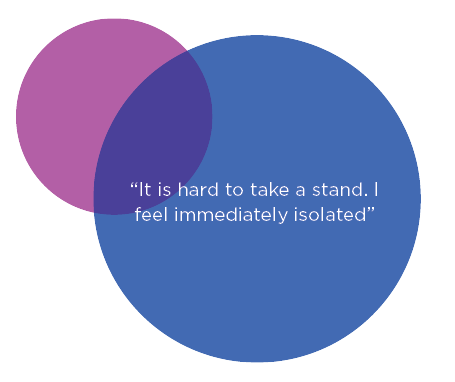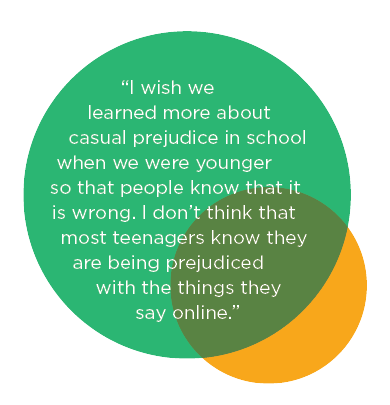Young Canadians Pushing Back Against Hate Online
 MediaSmarts conducted a survey of 1,000 youth ages 12 to 16 years old to better understand their attitudes and experiences with casual prejudice online; specifically, the motivations and external factors that influence their decisions whether or not to intervene. Study results uncover that youth experiences with online casual prejudice are common yet many youth do not respond because they don’t know what to do to make a difference. This research is a call for more effective interventions that will prepare, engage, and empower youth to push back against hate online.
MediaSmarts conducted a survey of 1,000 youth ages 12 to 16 years old to better understand their attitudes and experiences with casual prejudice online; specifically, the motivations and external factors that influence their decisions whether or not to intervene. Study results uncover that youth experiences with online casual prejudice are common yet many youth do not respond because they don’t know what to do to make a difference. This research is a call for more effective interventions that will prepare, engage, and empower youth to push back against hate online.
Report:
Key points and takeaways
What is this research about and why is it important?
Over 1,000 Canadian youth ages 12 to 16 were surveyed to find out how they experience and witness casual prejudice, including why they do or don’t intervene.
This research is important because seemingly low-level prejudice can often feed cultures of hatred and desensitize youth to seeing hate online. Normalized cultures of hatred provide the breeding grounds for targeted and more extreme acts of hate to be possible. Recent research shows that even small efforts to push back against hate online can have a profound impact on motivating others to intervene.
What is ‘casual prejudice’ or ‘cultures of hatred’ online?
- When people say or do things that are negative towards a particular group, but are not aimed at a specific person. For example, someone uses a racist term in a comment, or shares a meme of a person with a disability to make a joke.
Where do youth see/experience hate online?
- Twitter, Facebook, Snapchat, Instagram and YouTube were the top five reported platforms
- 100% of youth who use Facebook have seen hate on their feed at some point
- Youth were least likely to do something about (report) casual prejudice on YouTube compared to other platforms
How do youth experience or engage in casual prejudice?
- Most youth have witnessed casual prejudice at least sometimes, while just 10% do something about it frequently

- 25% of LGBTQ+ youth witness casual prejudice frequently, compared to 10% of all youth
- About 50% say they’ve never engaged in casual prejudice, and 10% admit to engaging in it often
- Boys were most likely to say they engaged in casual prejudice, either because they thought it was funny or to show they were a good sport
What are their attitudes towards casual prejudice?
- 70% of youth say it hurts their feelings and 80% say it’s important to do or say something in response, however most youth say it’s easier to talk about casual prejudice in private rather than in public
- Most say casual prejudice against anyone hurts their feelings, not just people they know or a group they are a part of. This suggests youth see casual prejudice as a social issue more than a personal one

- Only 20% think that they don’t have a right to say anything, that everyone gets picked on online, or that casual prejudice doesn’t matter
What factors encourage youth to push back?
- The top preferred methods of responding were to stop communication/block the person responsible or to talk to their parents
- Youth would be more likely to intervene if someone they knew told them it hurt their feelings (70%), the platforms they use had clear rules and tools to report behaviour (70%), and if they thought most people agreed with them or they had seen other people do something (70%)
What makes youth less likely to push back?
- Over 50% of youth don’t do something when they witness hate online because they don’t know what to do or they are afraid of making things worse

- About 50% say they have often seen people they know encourage casual prejudice by laughing or joining in
- About 50% say they are not sure if what they witnessed was prejudice or if the person really meant it
- 40% agree “it’s mostly just people joking around” or “people who complain are just looking for an excuse to be offended”
What are the recommendations?
- Youth need to be supported in developing the skills and knowledge to be able to recognize when something is prejudicial online and be given clear examples of how they could respond: “Help me understand what it is and what to do about it”
- Youth need to feel that their opinions and experiences matter and will be taken into account by those with decision-making capabilities
- Policy interventions should give young Canadians more opportunities to learn digital literacy in their classrooms, homes and wider communities
- Education interventions should incorporate resources on online hate into curriculum, lessons and programs at the earliest opportunity

- Parents need to be able to help their children recognize the signs of hate online and support their children to intervene in safe and respectful ways. Adults also need to set good examples as positive digital citizens
- Platforms and technology companies have a responsibility to create clear rules for what is considered acceptable behaviour on the platform as well as easy to use reporting mechanisms for flagging unacceptable behaviour and countering hate online: “I see lots of newbies come into a space for fun and get chewed up by the nastiness… Every company that makes a space should be making it a SAFE space”
Parents play an important role in helping their children. We encourage parents to talk to their children about the ways they can contribute to a positive online environment by pushing back when they encounter hate online. MediaSmarts has tip sheets and guides available here to help parents navigate these conversations.
